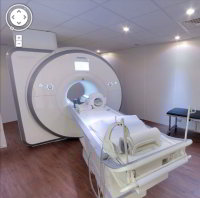Total Hip Replacement Surgery (Hip Prosthesis)
Fact Sheet: Total Hip Replacement
- Inpatient treatment following surgery: 5 days
- Recommended inpatient or outpatient rehabilitation in Germany: 10-14 days
- Earliest flight home: 10-12 days
- Follow up investigation by X-ray imaging: 6 months after surgery, then every 12 months
- Recommended time off work: 6 weeks
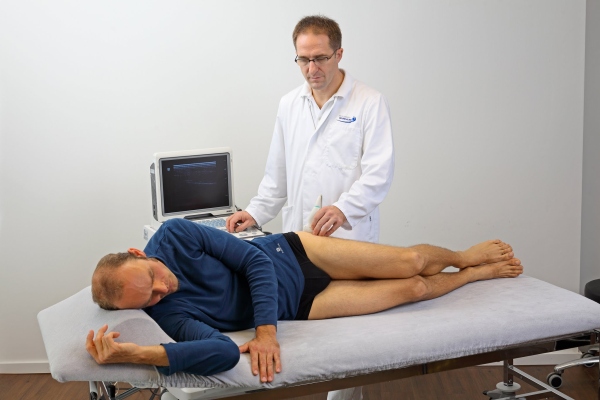 Ultrasound investigation of a patient in the hip centre of the Orthopaedic Gelenk-Klinik
Ultrasound investigation of a patient in the hip centre of the Orthopaedic Gelenk-Klinik
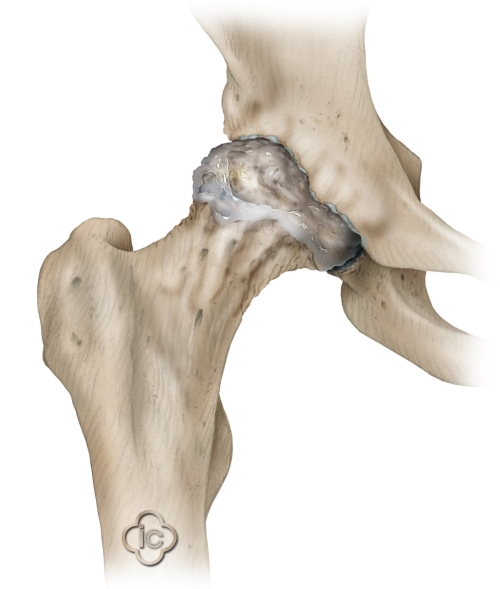 Hip osteoarthritis is degeneration and finally the destruction of the cartilage in the hip joint. This leads to a complete failure of the hip joint. A total hip replacement is a proven therapy to restore the mobility of the hip joint. © Implantcast
Hip osteoarthritis is degeneration and finally the destruction of the cartilage in the hip joint. This leads to a complete failure of the hip joint. A total hip replacement is a proven therapy to restore the mobility of the hip joint. © Implantcast
Total hip replacement surgery is advised in patients for whom the hip joint has been so severely damaged by osteoarthritis, that it is no longer possible to preserve the natural joint through hip resurfacing. In this case, both the femoral head and the socket of the hip joint are replaced by metal and polyethylene components designed to restore pain free mobility.
At the Gelenk-Klinik, our hip specialist is able to offer different designs and materials for the replacement joint and will advise on the most suitable for each individual case. The quality and durability of the hip replacement is largely dependent on the expert diagnosis, skill and experience of the hip specialist.
However, total hip replacement surgery is one of the most tested and successful joint replacement procedures available today.
Excellence in hip replacement surgery through experience and surgical technique
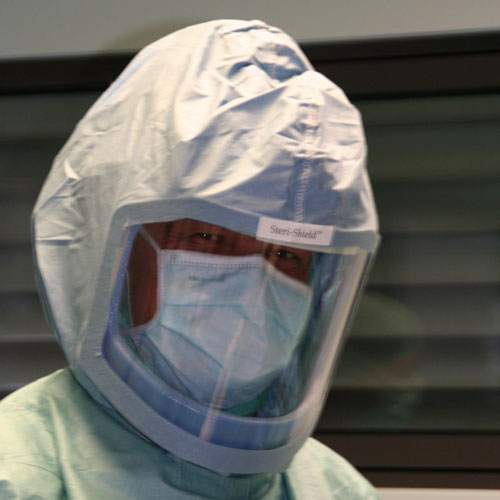 Closed circuit helmet systems create a clean-room atmosphere by preventing the spread of airborne germs by the operating theatre team.
Closed circuit helmet systems create a clean-room atmosphere by preventing the spread of airborne germs by the operating theatre team.
The quality and durability of hip replacement is largely dependent on the skill and experience of the hip specialist. At Gelenk-Klinik we have two dedicated hip surgeons, Dr Thomas Schneider and Dr. Martin Rinio with the experience of more than a hundred hip replacement surgeries each year.
Our hip specialists use a particularly minimally invasive surgical technique by accessing the joint through the gluteal muscle. The muscle fibres and nerves are pushed aside (similar to walking through a curtain) without damaging the muscle and leaving only a small scar. Patients undergoing minimally invasive hip replacement surgery at the Gelenk-Klinik are mobile the day after the surgery and experience quick and pain free rehabilitation.
Advantages of Minimally Invasive Hip Replacement Surgery at the Gelenk-Klinik
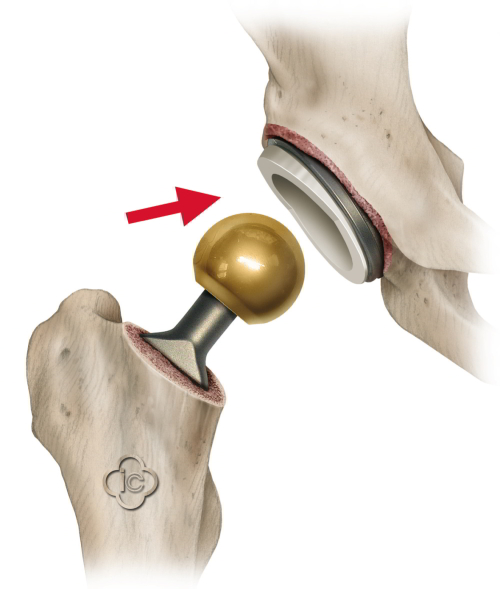 A total hip endoprosthesis consists of the cemented or ingrowing hip stem, and the mobile ball and socket components. Ball and socket are modular components width varying diameters to be chosen according to the particular anatomic situation of each patient. © Implantcast
A total hip endoprosthesis consists of the cemented or ingrowing hip stem, and the mobile ball and socket components. Ball and socket are modular components width varying diameters to be chosen according to the particular anatomic situation of each patient. © Implantcast
- Preservation of the Joint Capsule through minimally invasive hip surgery speeds up rehabilitation and reduces risk of hip luxation (dislocation)
- This Technique helps avoiding damage to muscles and nerves which speeds up rehabilitation and reduces post surgical pain
- A smaller, less visible scar (only 7-10 cm) gives a better cosmetic result
- Discrete location of the scar means that it can always be covered by trunks or a swimming costume
- Highly experienced surgeons (with a history of performing hundreds of technically sophisticated hip prostheses procedures), gives patient confidence and security
- The certification of the German Orthopaedic Society DGOOC as Centre for Arthroplasty in Germany indicates high quality in hip prosthesis. The certificate measures experience and quality of results in arthroplasty. Dr. Schneider has successfully proven his experience of over 100 successful hip prosthesis surgeries per year in order to fulfill the requirements of this certificate.
Total Hip Replacement Procedure
Hip Replacement Pre Surgery Checklist
- General health: examination and discussion of general health and any other existing medical conditions
- Weight: plan weight management program if required
- Anaesthesia: discussion on alcohol and tobacco use. Prepare list of regular medication. Discuss anaesthesia options
- Bone quality: bone densitometry testing is offered at the orthopaedic Gelenk-Klinik in order to recommend most suitable type of hip prosthesis and method of fixation
- Infection control: examination (including dental) to determine possible infections risk from underlying conditions
- What to bring: pack comfortable loose fitting trousers
First, the femur (thigh bone) is separated from the hip socket. Next, the damaged "ball" at the head of the femur is removed as well as any damaged cartilage and bone from the hip socket. A metal shell is then pressed into the hip socket and held in place by the press fit procedure. A plastic liner is fitted into the metal shell, completing the socket. The surgeon then works on the "ball" implant at the head of the femur. First, the end of the femur is hollowed out. Next, the shaft of the metal implant is inserted deep into the thigh bone and may be secured using bone cement. A metal or ceramic ball component is attached to the head of the shaft to complete the "ball" implant. Finally, the new ball and socket components are joined to form the new hip joint.
How is the implant secured in place? Cemented vs Ingrowing Hip Replacement
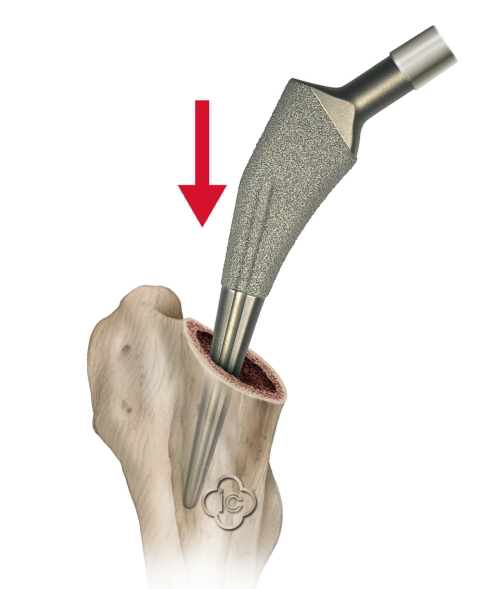 A total hip endoprosthesis can be secured in its location in the femur (thigh bone) as a cemented or as ingrowing prosthesis. The image above shows the rough and coated surfce of an ingrowing prosthesis, that facilitates ingrowth of bone material into the surface. © Implantcast
A total hip endoprosthesis can be secured in its location in the femur (thigh bone) as a cemented or as ingrowing prosthesis. The image above shows the rough and coated surfce of an ingrowing prosthesis, that facilitates ingrowth of bone material into the surface. © Implantcast
Securing the prosthesis with bone cement has the advantage of enabling the joint to return quickly to full weight bearing capacity. Mobilisation is usually possible as early as the first day after surgery. Cemented prostheses however, are not recommended for cases in which the stem of the prosthesis may one day be required to be replaced.
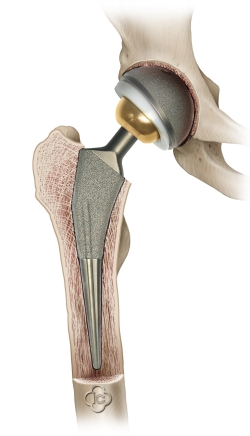 This image shows the location of a total hip endoprothesis inside the body. © Implantcast
This image shows the location of a total hip endoprothesis inside the body. © Implantcast
Elderly patients or patients with lower bone density (osteoporosis) benefit from the fast rehabilitation and rapid mobilisation possible following a cemented implant.
The younger and more active the patient, the more likely an ingrowing prosthesis is recommended by our hip specialist. The socket of the prosthesis will be fixed by the cement-free press-fit procedure. The stem of the hip prosthesis has a rough surface that encourages the natural ingrowth of bone structure. This provides a result that will be more resilient in active and sporty patients. Bone cement on the other hand is not as resilient as ingrowing prosthesis and has a tendency to erode under stress and regular high impact, it is therefore unsuitable in these cases. Some younger patients who are given an ingrowing hip implant, even go on to participate in long distance running events. For the majority of people however, this is not usually recommended and caution following hip replacement surgery is advised.
Total Hip Replacement Rehabilitation
The speed of rehabilitation following a hip replacement will vary according to how the prosthesis has been fixed in place. When bone cement is used to secure the prosthesis, full weight bearing is possible almost immediately.
If the prosthesis is not cemented into place, it is necessary to allow four to six weeks (for the femur bone to "grow into" the implant) before the hip joint is able to bear full weight and walking without crutches is possible.
Recommended Sports with Total Hip Prosthesis
- Riding a bicycle or exercise bike
- Nordic Walking
- Gymnastics
- Sailing
- Canoeing and Rowing
The main risk after hip replacement surgery is dislocation of the new hip joint (the ball jumps out of the socket). To prevent this, bending must be avoided. Dislocation is possible because during hip replacement surgery the capsule surrounding the joint is removed. After six months the capsule will have grown back and the risk of dislocation is back to normal again. Driving a car is normally possible within six weeks of hip replacement surgery.
Possible (with caution)
- Cross country skiing
- Ice skating
- Jogging and Running
- Dancing
Return to work is usually advised after six weeks of rehabilitation (twelve weeks should be allowed for professions which require long periods of standing or walking).
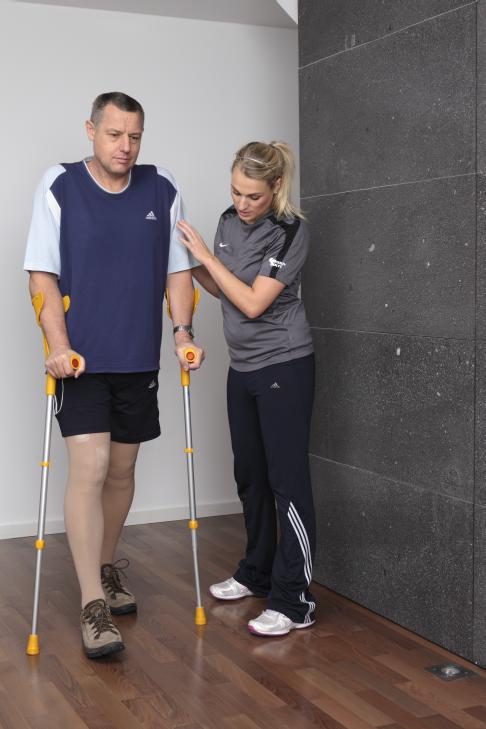 Early mobilisation of the patient after hip replacement is our highest priority. An ingrowing hip replacement requires a very careful approach to full weight bearing. © Gelenk-Klinik
Early mobilisation of the patient after hip replacement is our highest priority. An ingrowing hip replacement requires a very careful approach to full weight bearing. © Gelenk-Klinik
Sports which are safe to practise following a hip replacement include: cycling, nordic walking and hiking, swimming (front crawl only), gymnastic exercise, sailing, canoeing and rowing.
Sports which must be practised with caution include: cross country skiing (risk of falling), jogging and running, golf and lifting weights heavier than 20% of body weight.
Sports to be avoided include: alpine skiing, football, squash, tennis, skydiving, karate and judo.
How long does a Total Hip Replacement Replacement last?
Providing the new hip joint does not come under abnormal levels of strain, is not affected by accidental damage or through sport, the hip prosthesis normally lasts between fifteen and twenty five years.


 Dr. Martin Rinio, MD, Orthopedist, Hip-Surgeon and Trauma Surgeon
Dr. Martin Rinio, MD, Orthopedist, Hip-Surgeon and Trauma Surgeon